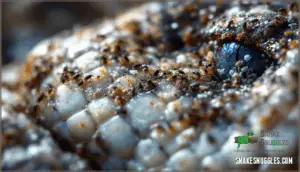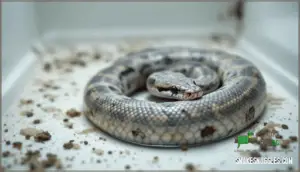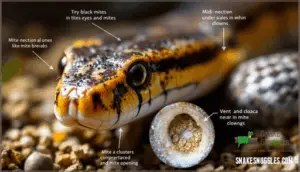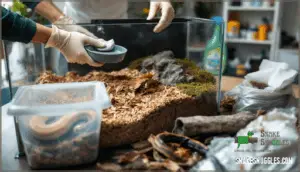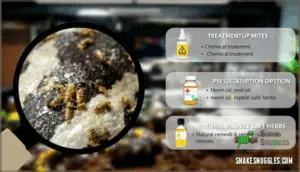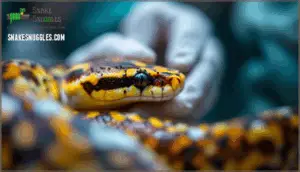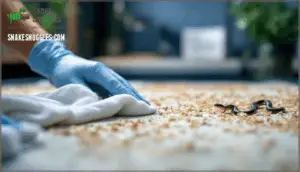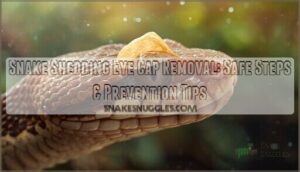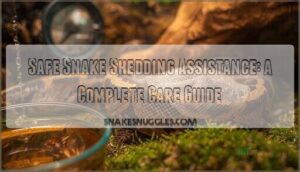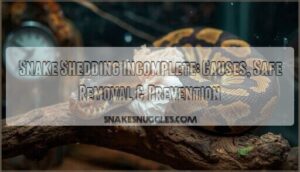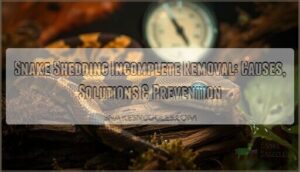This site is supported by our readers. We may earn a commission, at no cost to you, if you purchase through links.
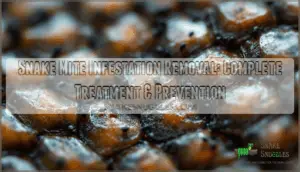
These parasites don’t just irritate your snake; they drain blood, spread disease, and multiply fast enough to overwhelm an entire enclosure in days. The good news? With the right approach, you can eliminate them completely and keep them from coming back.
Identifying mites early, acting quickly, and following through with proper treatment makes all the difference between a minor hiccup and a full-blown crisis that affects your snake’s health and your peace of mind.
Table Of Contents
- Key Takeaways
- Identifying Snake Mites
- Causes of Snake Mite Infestations
- Preparing for Treatment
- Choosing a Treatment Method
- Treating The Snake and Enclosure
- Removing Mites From Snakes
- Preventing Re-Infestation
- Monitoring Progress and Follow-Up
- Long-Term Snake Mite Control
- Frequently Asked Questions (FAQs)
- How do I get rid of snake mites?
- How do you treat snake mites without a vet visit?
- Can snake mites kill a snake?
- How long can you keep mites off a snake?
- Why is it important to treat a snake mite infestation early?
- How do you get rid of mite infestation?
- Does Dawn dish soap kill mites on snakes?
- How long does it take to get rid of reptile mites?
- What will eat snake mites?
- What are common snake mite treatment mistakes?
- Conclusion
Key Takeaways
- Snake mites are blood-feeding parasites that multiply rapidly and can cause anemia, disease transmission, and serious health problems if left untreated, so catching them early through regular inspections (every 3-5 days) around eyes, scales, and skin folds makes treatment much easier and more effective.
- Successful mite elimination requires treating both your snake and its entire enclosure simultaneously—quarantine the snake, apply vet-approved treatments like Fipronil spray or Ivermectin, completely replace substrate, and deep-clean everything with diluted bleach solution, repeating treatments every 5-10 days for at least three rounds to break the mite life cycle.
- Prevention starts with strict 30-day quarantine protocols for all new snakes, maintaining weekly deep-cleaning routines, and using mite-proof accessories like plastic or ceramic items instead of porous materials where parasites can hide and breed undetected.
- Wild-caught snakes carry mite infestation rates up to 65.8%, and common mistakes like skipping follow-up treatments, ignoring environmental cleaning, or stopping too early allow mites to return quickly, so consistent vigilance and thorough multi-week treatment plans are essential for long-term control.
Identifying Snake Mites
Catching snake mites early can make all the difference between a quick fix and a drawn-out battle. You’ll need to know what you’re looking for, where to look, and what your snake’s actions might be telling you.
Let’s walk through the key signs that’ll help you spot these tiny troublemakers before they become a bigger problem.
Visible Signs of Mites
When’s the last time you gave your snake a close-up inspection—and would you even know what you’re looking for? Snake mites are tiny parasites, about pinhead-sized, appearing as black, red dots or gray specks crawling on your snake’s skin.
Look closely under scales, around the eyes, nostrils, and in skin folds where these freeloaders hide. You’ll also spot their calling cards: tiny white mite droppings that look like ash or dust, plus excessive scratching or restlessness.
Finding visible mites means it’s time to act fast!
Behavioral Symptoms of Infestation
Your snake isn’t just being dramatic—those constant soaks, frantic rubbing sessions, and sudden mood swings are actually its way of screaming for help. Snake mite symptoms include changes in conduct that signal distress:
- Frequent soaking in water dishes for hours
- Excessive scratching and increased rubbing against objects
- Appetite changes or complete appetite loss
- Lethargy signs like reduced movement and sluggishness
- Erratic conduct such as restlessness or irritability
These symptoms mean mites are feeding on your snake, causing intense discomfort that demands immediate attention.
Common Areas to Check for Mites
Think of mites like tiny vampires—they don’t just show up anywhere; they have favorite hiding spots where your snake can’t easily shake them off. Focus on vulnerable areas where mites gather to feed and breed, making detection easier and removal more effective.
Mites hide in your snake’s most vulnerable spots—eyes, nostrils, skin folds—where they feed and breed undisturbed
| Body Area | Why Mites Gather Here | What to Look For |
|---|---|---|
| Around eyes and nostrils | Thin skin, moisture, hard to reach | Tiny black or gray dots, irritation |
| Under scales and skin folds | Protected hiding spots, warmth | Moving specks, ash-like mite droppings |
| Gular fold (throat area) | Moisture retention, wrinkled skin | Clusters of mites, redness |
| Vent and cloaca | Warm, moist environment | Mites congregating, white debris |
| Inside shed skin | Mites cling during shedding | Black dots stuck to shed, mite eggs |
Check your enclosure’s substrate and accessories too—mites don’t just live on your snake; they hide in decor, water dishes, and bedding between feedings.
Causes of Snake Mite Infestations
Understanding what causes snake mite infestations is the first step in stopping them before they start. These tiny parasites don’t just appear out of nowhere—they come from specific sources that you can control.
Let’s look at the three main ways mites find their way into your snake’s enclosure.
Poor Hygiene and Contamination
When grime builds up and cleaning gets pushed to "tomorrow," you’re basically rolling out a red carpet for these bloodsucking pests. Dirty enclosures with waste buildup create perfect mite hideouts, while unclean hands spread trouble between tanks.
Keep your hygiene game strong:
- Disinfection matters: Clean surfaces weekly to prevent cross contamination.
- Water quality counts: Stale bowls attract mites and bacteria.
- Food contamination risks: Fresh prey only, no dirty dishes.
Consistent cleaning stops reinfestation before it starts.
Wild-Caught Snakes and Cross-Contamination
Wild-caught snakes remain the most common source of snake mite infestations in captive collections, with carrier rates reaching up to 65.8% in some surveys. Cross contamination happens fast once these arrivals join your collection, spreading mites to healthy snakes within weeks.
Quarantine protocols spanning at least 30 days are non-negotiable for preventing snake mites and blocking disease transmission. Strong biosecurity measures, including separate feeding tools and hand washing between contact, minimize epidemiological risks before infestations spiral out of control.
Reptiles can carry various endoparasites and ectoparasites.
Infested Enclosures and Accessories
Your enclosure and its accessories can harbor mites for weeks, turning what looks like a clean setup into a secret mite motel. Mites hide in substrate layers, cage decorations, and water bowls, making complete removal essential.
Enclosure cleaning means scrubbing every corner with safe products, then replacing substrate and accessories entirely. Don’t cut corners here—mite eradication depends on thorough habitat cleaning and enclosure sanitation.
Toss heavily infested items that can’t be properly disinfected, because some accessory materials just can’t be saved.
Preparing for Treatment
Before you can tackle those mites head-on, you need to set the stage for successful treatment. This means isolating your snake, breaking down the enclosure completely, and tossing anything that’s harboring these tiny pests.
Let’s walk through each critical prep step to make sure you’re ready to win this battle.
Quarantining The Snake
The first step in winning the mite battle is simple: move your snake to a clean, temporary setup right away. This quarantine period, usually lasting a few weeks, prevents spread to other pets and gives you a clear shot at eliminating every last mite.
Use a basic separate enclosure with minimal accessories—easier monitoring means faster detection of any stragglers. You’ll reduce stress while keeping close tabs on their health during this significant quarantine duration.
Cleaning and Disinfecting The Enclosure
Once your snake’s safely tucked away, it’s time to strip that enclosure down and wage war on every hiding spot those sneaky mites could’ve claimed. This deep cleaning isn’t optional—it’s your best shot at preventing re-infestation and protecting your pet.
Here’s your step-by-step cleaning process for habitat cleaning and disinfection:
- Remove everything. Pull out substrate, hides, water bowls, and decorations for thorough snake enclosure cleaning.
- Select your disinfectant. A 3% bleach solution works great, but pet-safe disinfectant selection matters—choose what suits your enclosure materials.
- Scrub and rinse like you mean it. Safe cleaning means hitting every corner, then rinsing until no chemical smell remains.
Removing Infested Items
Some items in that enclosure are too far gone to save, and holding onto them is like inviting mites back for round two. Porous decorations, mite-infested bedding, and heavily contaminated supplies should go straight into the trash—proper disposal of infested materials is non-negotiable.
For salvageable items like ceramic hides or water bowls, you’ve got options: soak them in bleach solutions, try freezing items for several days, or baking items in a low oven to kill mites. Thorough enclosure cleaning and mite removal mean replacing what you can’t disinfect. Item replacement gives your snake a fresh start, free from hidden parasites.
Choosing a Treatment Method
Once you’ve got your snake safely quarantined and the enclosure cleaned out, it’s time to pick your weapon against these tiny bloodsuckers. You’ve got three main routes to choose from: chemical treatments that pack a serious punch, prescription medications from your vet, or natural remedies that take a gentler approach.
Let’s break down each option so you can decide what works best for your scaly friend.
Fipronil Spray and Its Application
Fipronil spray works like a targeted strike team, hunting down mites without harming your snake when you use it correctly. This chemical treatment boasts high Fipronil efficacy against snake mites.
Application methods are simple: lightly mist your snake’s body, avoiding the eyes and mouth, then let it air-dry for 10-15 minutes.
Safety concerns include proper ventilation and never over-applying. Watch for resistance risks with repeated use, and consider rotating alternative sprays to keep those mites guessing.
Ivermectin and Other Medications
Beyond Fipronil, medications like ivermectin pack a punch against stubborn mites when used under veterinary guidance. Ivermectin dosage usually runs 0.2 mg/kg subcutaneously once weekly for three weeks, though you’ll need repeat applications since it won’t touch mite eggs. Moxidectin usage offers another topical option, while permethrin safety requires extreme caution—never use it near cats. Ivermectin is most effective when administered via subcutaneous injection.
Watch for resistance issues with any single treatment, and remember the environmental impact when disposing of these antiparasitic medications properly.
Natural and Home Remedies
While medications address heavy infestations, natural remedies for mites offer gentler alternatives worth exploring. Neem Oil, when diluted properly, can repel parasites without harsh chemicals, and Cedar Oil works similarly when applied carefully. Diatomaceous Earth, sprinkled around (not inside) enclosures, creates barriers mites can’t cross. Heat Treatment—raising temperatures to 120°F for several hours—kills all life stages, though your snake must be removed first.
Here’s what works:
| Remedy | Application | Effectiveness |
|---|---|---|
| Neem Oil | Dilute 1:10, light mist | Moderate repellent |
| Cedar Oil | Spray enclosure only | Mild deterrent |
| Diatomaceous Earth | Dust barrier outside tank | Good for prevention |
| Heat Treatment | 120°F for 4+ hours | Kills all stages |
Essential Oils need extreme caution—respiratory issues can develop from improper use, so never spray directly on your snake.
Treating The Snake and Enclosure
Once you’ve chosen your treatment approach, it’s time to put it into action. You’ll need to treat both your snake and its enclosure at the same time, or those mites will just bounce right back.
Here’s how to tackle each part of the treatment process effectively.
Applying Topical Treatments
When you’re ready to tackle those bloodsucking pests head-on, topical treatments become your first line of defense. Fipronil spray and Ivermectin are your go-to options, but applying topical treatments requires careful technique:
- Spray application: Lightly mist the product, avoiding sensitive areas like eyes and nostrils.
- Dosage accuracy: Follow label instructions precisely to prevent toxicity.
- Product safety: Choose reptile-safe formulas, never use dog or cat products.
- Resistance issues: If mites persist after two treatments, switch methods.
Treat your snake gently during application, and you’ll see those parasites vanish.
Soaking The Snake
A good soak can work wonders alongside your topical treatment, giving those stubborn mites nowhere to hide. Fill a shallow container with warm water (85-90°F), and let your snake relax for 15-20 minutes. This soaking duration helps drown mites and loosens their grip on your pet’s scales. The solution concentration doesn’t need anything fancy—plain warm water does the trick.
Soaking benefits include stress reduction for your snake while treating snake mites effectively. After applying topical treatments, gently pat your snake dry with a clean towel before returning it to its temporary enclosure.
Replacing Substrate and Accessories
While your snake’s getting its spa treatment, let’s flip the script on that old bedding—because every last piece of substrate needs to go, now. Toss it all, and start fresh with miteproof substrate like paper towels or newspaper. Here’s your quick action plan:
- Substrate Disposal: Bag and trash everything immediately
- Accessory Selection: Choose smooth, non-porous materials you can easily disinfect
- Cleaning Protocols: Soak accessories in 10% bleach solution for 30 minutes
- Safe Materials: Stick with mitefree substrate options during treatment
Your enclosure becomes a fortress when you eliminate every hiding spot.
Removing Mites From Snakes
Once you’ve treated the enclosure and applied medications, you need to physically remove mites from your snake’s body. This hands-on process requires patience and the right techniques to make certain you’re getting every last parasite.
Let’s look at the most effective removal methods and the safety precautions you should follow.
Effective Removal Methods
If you’ve ever felt like you’re fighting an uphill battle against these tiny bloodsuckers, you’ll be relieved to know there are several proven methods to reclaim your snake’s health. Start with topical applications like Fipronil spray, following veterinary consultation for proper dosing. Soaking the snake in lukewarm water helps dislodge mites quickly.
Complete substrate removal and enclosure sterilization are essential—mites hide everywhere. Some keepers use natural predators like Taurrus mites for chemical-free control.
Applying topical treatments combined with thorough cleaning delivers the most effective removal methods. Don’t skip the deep clean, it’s your secret weapon against re-infestation.
Safety Precautions for Snake Owners
Protecting yourself during treatment isn’t just about gloves and goggles; it’s about creating a barrier between you and a mite explosion. Here’s your safety checklist:
- Working with chemicals requires veterinarian consultation to avoid toxic chemicals that harm you or your snake.
- Wear protective gear to minimize zoonotic risks during treatment.
- Assure adequate airflow when using chemical treatment risks like sprays.
- Practice safe disposal of infested materials immediately after removal.
Heat treatment and safe alternative methods reduce exposure while keeping everyone protected.
Preventing Re-Infestation
You’ve won the battle against those pesky mites, but the war isn’t over yet. Without the right prevention steps, these blood-sucking parasites can sneak back into your snake’s life faster than you’d think.
Let’s look at three key strategies that’ll keep your scaly friend mite-free for good.
Maintaining Proper Hygiene and Cleaning
Your best defense against snake mites is a solid cleaning routine, plain and simple. Commit to deep cleans every two weeks—scrub surfaces, practice preventative disinfection with reptile-safe products, and stay on top of waste removal daily.
Good water quality matters too, so change bowls frequently. Follow consistent interaction protocols, like washing your hands before and after contact.
Enclosure sanitation isn’t glamorous, but maintaining proper hygiene and cleaning keeps your snake healthy and mite-free.
Regularly Inspecting The Snake
Catching mites early is like spotting a tiny fire before it becomes a wildfire—it saves you (and your snake) a whole lot of trouble. Make regular health checks part of your routine, ideally every three to five days. Early detection through consistent inspection frequency helps you spot visual cues before a full-blown snake mite infestation takes hold.
During times you’re holding your snake, look for:
- Tiny black or red dots crawling on the skin, especially around eyes and heat pits
- Ash-like mite droppings appearing as fine dust on scales
- Behavioral changes like excessive soaking, rubbing, or restlessness
Keep simple record-keeping notes about what you observe—it helps track patterns and protects your reptile’s health long-term. Identifying snake mites quickly means easier treatment and a happier, healthier snake.
Using Mite-Proof Substrate and Accessories
Predatory mites and smart substrate choices act as your snake’s invisible security team. Moisture-retaining substrates like coconut husk foster beneficial predatory mites, which can cut snake mite populations by over 97% in just 15 days. Paper towels work great during active treatment for spotting survivors. Sterilize all substrate by freezing or baking above 106°F before use, and choose plastic or ceramic accessories over wood—they don’t harbor mites and are easy to disinfect.
| Best Choice | Why It Works |
|---|---|
| Coconut husk substrate | Holds humidity, fosters predatory mites |
| Paper towels (temporary) | Makes mites visible during treatment |
| Plastic/ceramic accessories | Easy to clean, mites can’t hide |
Bioactive enclosures with predatory mites create a safe environment that fights reinfestation naturally, protecting your enclosure without repeated chemical exposure.
Monitoring Progress and Follow-Up
Treatment doesn’t end when the mites disappear. You’ll need to keep a close eye on your snake over the next few weeks to make sure those parasites are truly gone and your pet’s on the road to recovery.
Let’s look at how to monitor your snake’s progress, when to schedule follow-up treatments, and what to do if your current approach isn’t working.
Tracking The Snake’s Recovery
Once treatment starts, tracking the snake’s recovery becomes your roadmap to success. You’ll want to monitor shifts in behavior, appetite improvements, and clinical signs resolution daily. Mite count reduction should be noticeable within the first week, and behavior normalization usually follows close behind. Watch for decreased lethargy, less frantic soaking, and a return to normal hiding patterns—these signal your snake’s bouncing back. Shedding frequency matters too, since healthy snakes shed cleanly once treatment kicks in. Regular health checks help you catch any lingering problems early, so you can adjust your approach before mites make a comeback.
- Check for visible mites daily using white paper substrate to spot any black dots or "mite dust" that signal ongoing infestation
- Monitor appetite closely since over 80% of snakes resume normal feeding within four weeks of effective treatment
- Watch soaking behavior as excessive water time should drop off within two weeks if mites are clearing out
- Track shedding quality because complete, clean sheds indicate your snake’s skin is healing properly from mite damage
Scheduling Follow-Up Treatments
Once you’ve seen those first signs of improvement, the real work begins—mapping out your follow-up treatments to crush any mite eggs or stragglers before they turn into round two. Treatment intervals matter because the mite life cycle runs about 5-7 days, so you’ll need to repeat applications every 5-10 days for at least three rounds.
Watch for re-infestation signs like new mite dust or behavioral backslides. Monitoring effectiveness through daily checks helps you catch problems early and adjust your long-term plans. Scheduling follow-up treatments isn’t optional—it’s your insurance policy against preventing mite infestations from sneaking back in.
| Treatment Round | Timing After Initial Treatment |
|---|---|
| Second application | 5-7 days |
| Third application | 10-14 days |
| Fourth application | 15-21 days (if needed) |
| Final inspection | 30 days |
Adjusting Treatment Methods as Needed
Sometimes the mites don’t get the memo that your treatment plan was supposed to work, so you’ll need to shift gears and try something different. Mite resistance can develop when treatments fail to eliminate the entire population, leading to reinfestation. Monitor efficacy closely during follow-up treatments, and if you’re not seeing results, consider treatment combinations or switch methods entirely based on severity assessment.
Here’s when to adjust your approach:
- Persistent mites after two treatments: Switch from your current method to an alternative like Fipronil or Ivermectin to combat resistance development
- Behavioral symptoms return: Your snake’s still soaking excessively or rubbing, signaling the mites are winning and you need stronger measures
- Species variations matter: Some snakes tolerate certain treatments better than others, so tailor your snake mite treatment methods accordingly
Long-Term Snake Mite Control
You’ve won the battle against snake mites, but keeping them gone means staying ahead of the game. Long-term control isn’t about constant vigilance—it’s about building smart habits into your routine.
Here’s how to keep your snake mite-free for the long haul.
Quarantine and Isolation Protocols
Long-term mite control starts with one non-negotiable rule: every new snake gets a mandatory 30-day quarantine before meeting your collection. This quarantine period is your safety net against cross-contamination risks, giving you time to spot any hitchhikers before they spread. The importance of quarantine can’t be overstated—it’s your first line of defense.
Here’s your quarantine essentials checklist:
- Isolation setup: Use a separate room with dedicated equipment only for quarantined snakes.
- Quarantine duration: Stick to the full 30 days, no shortcuts.
- Stress reduction: Keep interaction minimal and environment stable.
- Monitoring protocols: Inspect daily for mites, behavioral changes, and appetite.
- Equipment hygiene: Never share tools between quarantine and your main collection.
These quarantine procedures for snakes protect your entire reptile family.
Ongoing Snake Care and Maintenance
Staying on top of routine care is what separates a mite-free snake from one that keeps getting reinfested. Enclosure upkeep includes regularly inspecting the snake during interaction, checking under scales and around eyes. Monitor hydration methods and diet adjustments closely—healthy snakes resist pests better.
These practices form your foundation for long-term snake mite control and preventing snake mite infestations.
| Care Task | Frequency | Mite Prevention Impact |
|---|---|---|
| Snake enclosure hygiene | Weekly deep clean | Removes eggs and larvae |
| Regular interaction | 2-3 times weekly | Allows early mite detection |
| Shedding assistance | As needed | Prevents trapped mites under retained skin |
| Hydration methods check | Daily | Maintains reptile health and immune function |
Future Prevention Strategies
Building a sustainable defense starts with smart habits that keep mites from ever gaining a foothold in the first place. Long-term snake mite control means weaving integrated pest management into your routine:
- Biosecurity protocols — quarantine procedures for all new arrivals
- Proactive monitoring — weekly inspections catch problems early
- Maintaining a clean environment — regular enclosure disinfection eliminates hiding spots
- Novel repellents — cedar-based substrates deter mites naturally
- Mite prevention measures — monitor genetic resistance trends in breeding programs
Frequently Asked Questions (FAQs)
How do I get rid of snake mites?
Snake mites feed on blood and spread fast, so act quickly. Quarantine your snake immediately, apply a vet-approved treatment like Fipronil spray, and thoroughly disinfect the enclosure with bleach solution. Multiple treatments over several weeks target the mite life-cycle effectively.
How do you treat snake mites without a vet visit?
When mites crash your snake’s party, think of it as your call to action. Isolate your snake immediately, then deep-clean the enclosure with a diluted bleach solution (1:10 ratio), rinse thoroughly, and apply a pet-safe disinfectant.
Toss all bedding and porous decorations—they’re mite hideouts now.
Can snake mites kill a snake?
While mites alone rarely cause immediate death, severe infestations pose serious danger. Heavy mite loads can trigger anemia from blood loss, opening doors to secondary infections like septicaemia.
Stress impact weakens immunity, creating a cascade of health complications including lethargy that, without intervention, can prove fatal.
How long can you keep mites off a snake?
With consistent preventative measures, quarantine protocols, and vigilance, you can keep mites off your snake indefinitely. Re-infestation timelines depend on environmental mite survival and treatment effectiveness duration.
Longterm snake mite control requires understanding the snake mite life cycle and maintaining strict hygiene to prevent reinfestation.
Why is it important to treat a snake mite infestation early?
Early intervention stops snake mites from spiraling out of control, preventing serious health complications like anemia, skin irritation, and behavioral changes.
These parasites multiply fast and act as disease vectors, so catching them early makes treatment more effective and prevents the infestation from spreading through your collection.
How do you get rid of mite infestation?
Breaking bad mite habits starts with quarantine. Isolate your snake immediately, discard all substrate and porous decor, then deep-clean the enclosure with diluted bleach (rinse thoroughly twice).
Apply veterinary guidance-approved treatment options like fipronil spray directly to your snake, targeting common hiding spots. This approach minimizes re-infestation risks through consistent careful treatment.
Does Dawn dish soap kill mites on snakes?
You might’ve heard that Dawn dish soap can kill snake mites, and it’s partly true. A diluted solution can suffocate mites temporarily, but it’s not a standalone fix.
Mix a few drops with water, apply gently, and rinse thoroughly—soap residue irritates skin.
How long does it take to get rid of reptile mites?
Think of mite treatment like a marathon, not a sprint—you’ll need two to four weeks to win this race. Your snake mite treatment timeline depends on the mite lifecycle, which spans roughly two weeks from egg to adult. Reinfestations happen when eggs hatch after initial treatment, so you must treat both your snake and enclosure multiple times.
Environmental factors and species variation affect treatment duration, but consistent effort across all life cycle stages guarantees complete eradication and minimizes re-infestation risks.
What will eat snake mites?
You won’t find anything that naturally eats snake mites in a typical home setting. However, Taurrus predatory mites offer biological control—they hunt and consume snake mites, providing natural snake mite control without harsh chemicals.
What are common snake mite treatment mistakes?
Picture your snake’s enclosure like a crime scene—every corner matters. Common snake mite treatment mistakes include skipping quarantine, dosage errors, misidentifying mites, ignoring environment cleaning, and improper application of treatments.
Chemical treatment risks can harm your pet, so consult a veterinarian about natural remedies and safe reptile enclosure management strategies.
Conclusion
Think of snake mite infestation removal like debugging a system—you need to eliminate every trace, or they’ll replicate and crash everything. By identifying mites early, treating aggressively, and committing to prevention protocols, you’re not just solving today’s problem—you’re protecting your snake’s future health.
Stay vigilant with quarantine, maintain spotless hygiene, and inspect regularly. Mites are persistent, but with the right strategy, you’re always one step ahead. Your snake depends on it.

